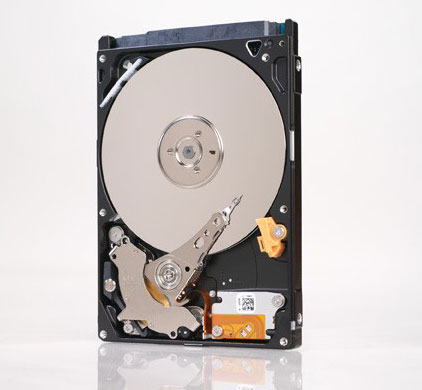Seagate's Momentus XT Reviewed, Finally a Good Hybrid HDD
by Anand Lal Shimpi on May 24, 2010 9:31 AM EST- Posted in
- Storage
- SSDs
- Seagate
- Momentus XT
- Hybrid Drive
- SSHDs
Final Words
Seagate's Momentus XT should become the standard hard drive in any notebook shipped. The biggest problem I have with using any brand new machine, regardless of how fast it is, is that it never feels fast because it usually has a HDD and not an SSD. While the Momentus XT isn't quite as fast as an SSD, it's a significant improvement over the mechanical drives found in notebooks today.
In many cases the Momentus XT performs like a VelociRaptor, but in a lower power, quieter package. The impact of adding just a small amount of SLC NAND is tremendous. I wonder what kept Western Digital from sticking some NAND on its VelociRaptor instead of giving us the lackluster upgrade we got earlier this year.
The potential for hybrid drives continues to be huge, what Seagate has shown here is that with a minimal amount of NAND you can achieve some tremendous performance gains. There's no reason for any performance oriented mechanical drive to ship without at least some small amount of NAND on board. There's also much room for Seagate to innovate. We could see drives with more NAND or truly hybrid drives that provide read and write caching in NAND.

Compared standard 2.5" drives, the Momentus XT will set you back an additional $50 - 90 depending on the capacity point. The added cost is absolutely worth it. It's still a lot cheaper than an SSD since we're in the sub-$0.31 per GB area while SSDs sell in the range of $2 - $4 per GB.
If you're not going to buy an SSD for your notebook, then definitely go for the Momentus XT. I'd almost go as far as to say it's a great option for desktop users but unless you're on a budget you're probably better served by a small SSD + 3.5" drive on the desktop.










120 Comments
View All Comments
codedivine - Monday, May 24, 2010 - link
Another request is to compare performance against a non-hybrid 7200rpm Momentus, which is the same drive minus the flash. That will make the performance benifits clearer.Ralos - Monday, May 24, 2010 - link
How come a Velociraptor is faster the second time, just after a reboot?It should be the same each time, should it not?
UltraWide - Monday, May 24, 2010 - link
It's due to the fact that it's a mechanical drive with moving parts. At some times the head might be positioned closer to the data requested resulting in improved performance whereas other times it may have to wait for the next revolution to come to the same data. This creates slight variations in performance.icrf - Monday, May 24, 2010 - link
I don't think that makes sense. The second and third runs are consistently faster than the first run, and relatively consistent with each other. What causes a purely mechanical hard drive to learn?kmmatney - Monday, May 24, 2010 - link
I agree - the velocirapter should have parked its read head between boots, so it really shouldn't have been faster between the runs. It must have some tricks.Anand Lal Shimpi - Monday, May 24, 2010 - link
That would be Windows 7's SuperFetch at work.bitterman0 - Monday, May 24, 2010 - link
Actually, I was thinking about comparing this hybrid drive to Windows' own methodology of clustering frequently used data on a USB Flash drive (ReadyBoost, is it?). Granted, USB Flash is not as fast as this on-board SLC, and as far as I understand ReadyBoost is using USB Flash for lower latency purposes only. Yet, from what I hear ReadyBoost helps quite a bit in the OS boot process.But then I've noticed this reply indicating that SuperFetch was NOT disabled in any of the tests. Well, that pretty much invalidates all results obtained in the tests, don't you think? With 4GB of RAM, SuperFetch overrides much of 4GB of read-only NAND cache, and most likely confuses the cache controller. Have the test configuration had 8GB (or more) RAM, the situation would have been much worse still.
Is there a possibility to redo the same tests with SuperFetch turned OFF? That would be a synthetic benchmark for Windows Vista and Windows 7 users, but it will be closer to reality for Windows XP, Windows Server and non-Windows users.
leexgx - Monday, May 24, 2010 - link
you need to disable the ready boot or ready boost (i got to go out now so not going to check logs to what is doing the boot optimization) as i see 400mb or so of ram been free up after 20-30 secs after desktop is shownjaydee - Monday, May 24, 2010 - link
Does SuperFetch play the same role on the Momentus XT? Is someone were running WinXP, would we then expect the boot times to be about the same as the Velociraptor, and both of these have the same boot times no matter how many times you rebooted?void2 - Monday, May 24, 2010 - link
Not exactly. This is the result of ReadyBoot (improved version of "boot prefetch" from Windows XP).SuperFetch in Windows 7 is not even active for a few minutes after boot (unlike, alas, Vista).